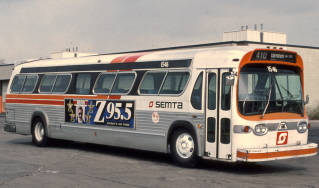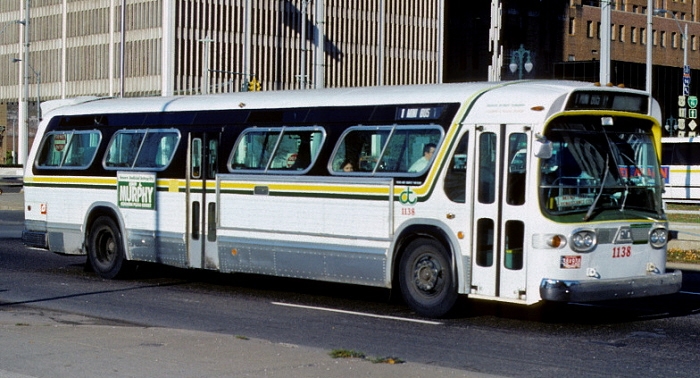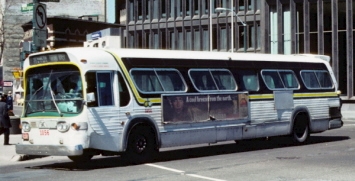| . |
| . |
| . |
| D-DOT'S FIRST FLEET OF NEW BUSES (New D-DOT Coaches for One Dollar!) |
In January, 1975, an additional $12.5 million federal grant was also obtained by SEMTA for an additional 99 coaches and other new equipment, which would increase the total number of new buses for the region to 247 coaches. Nearly 80% of the total funding would go towards new buses slated for Detroit, while the remainder of funds would go toward purchasing new buses for SEMTA's suburban bus operation. The additional grant money would also allow SEMTA to purchase an additional fifty-plus coaches for DDOT. The local share money was obtained through a special half-cent state gasoline and weight tax diverted to mass transit.
Two orders totaling 196 new buses were placed with General Motors Truck & Coach in Pontiac, Mich., with 148 of the buses being slated for DDOT, and 48 earmarked for SEMTA. An order for an additional 51 new buses for DDOT would later go to the AM General Corp. The arrival of the GMC coaches would be the first new buses for the region since the 154 fleet of GMC T8H-5307As which were also purchased through SEMTA were delivered in 1972.
| . |

| . |
| ||||||||||||||||||||||||||
| Click here to return to "THE D-DOT YEARS" Main Page. |
| For Comments & Suggestions Please Contact Site Owner at: admin@detroittransithistory.info |
| This June 11, 1975 Detroit Free Press photo shows a smiling Mayor Coleman A. Young along-side one of the city's new $1-a-year D-DOT buses. |
| The air-operated parking brake was activated by a control valve knob located on a tower to the right of the driver's seat. |
In addition to being the first new buses to arrive in Detroit equipped with power-steering, these 48-passenger coaches came equipped with a number of other features new to the city of Detroit. These new features included a computerized wheel-lock control braking system to prevent skidding, foot-operated directional signal switches, plush cushioned brightly-colored seats, and improved interior lighting with florescent lighting moved from the center isle to back-lit advertising sign panels along both sides of the coach.
| . |
(Southeastern Michigan Transportation Authority), also
received a fleet of GMC T6H–5307As. After the completion
of the DDOT order, production continued at GMC Truck &
Coach on the 48 coaches (#1521-1568) slated for SEMTA.
These would become the first new buses to be both owned
and operated by SEMTA. All of the advance new features
found on the DDOT fleet were also included on the SEMTA
coaches, except the SEMTA coach fleet had blue forward
facing suburban style seats with no center exit doors.
The last of the remaining #1000-1100-series T6H-5307As were all retired by the mid-1990s.
| . |
|

| (Photo courtesy of the Jim Husing Collection) |

| DDOT's original, but short-lived, livery of white with black trimmed windows and green and yellow striping was introduced on the #1000-1100 series GMC "new-look" fleet that began arriving in June of 1975. Because the buses were purchased through the regional transit authority SEMTA, the SEMTA logo decal was displayed on the transmission door panel. (Melvin Bernero photobucket.com collection, used by permission of Melvin Bernero) |
On Tuesday, June 10, 1975, Mayor Coleman A. Young would show off the city's brand-new dollar-apiece buses to the news media. The Detroit Free Press would quote the mayor as saying, "Too many of our buses are damn near collapse," and he explained that the new buses would help upgrade the city's bus service.


| . |
| PRINTER- FRIENDLY WEB-PAGE |
| (Reformatted 02-06-14) |



| .. |
| The unique website which takes a detailed look back at the History of Public Transportation in and around the City of Detroit. |









